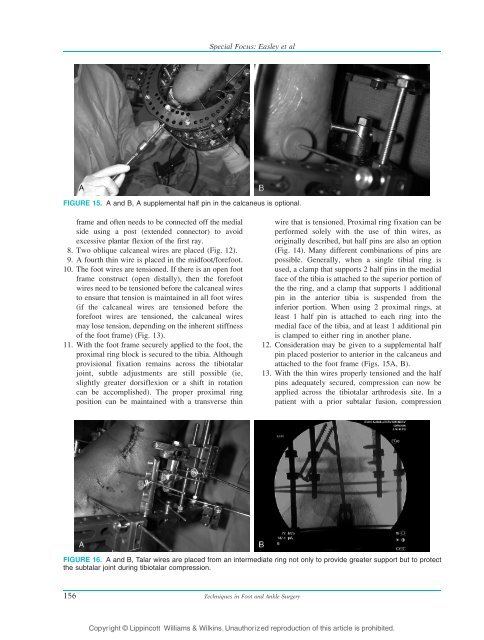Ankle Arthrodesis Using Ring External Fixation - Orthofix.com
Ankle Arthrodesis Using Ring External Fixation - Orthofix.com
Ankle Arthrodesis Using Ring External Fixation - Orthofix.com
Create successful ePaper yourself
Turn your PDF publications into a flip-book with our unique Google optimized e-Paper software.
FIGURE 15. A and B, A supplemental half pin in the calcaneus is optional.<br />
frame and often needs to be connected off the medial<br />
side using a post (extended connector) to avoid<br />
excessive plantar flexion of the first ray.<br />
8. Two oblique calcaneal wires are placed (Fig. 12).<br />
9. A fourth thin wire is placed in the midfoot/forefoot.<br />
10. The foot wires are tensioned. If there is an open foot<br />
frame construct (open distally), then the forefoot<br />
wires need to be tensioned before the calcaneal wires<br />
to ensure that tension is maintained in all foot wires<br />
(if the calcaneal wires are tensioned before the<br />
forefoot wires are tensioned, the calcaneal wires<br />
may lose tension, depending on the inherent stiffness<br />
of the foot frame) (Fig. 13).<br />
11. With the foot frame securely applied to the foot, the<br />
proximal ring block is secured to the tibia. Although<br />
provisional fixation remains across the tibiotalar<br />
joint, subtle adjustments are still possible (ie,<br />
slightly greater dorsiflexion or a shift in rotation<br />
can be ac<strong>com</strong>plished). The proper proximal ring<br />
position can be maintained with a transverse thin<br />
wire that is tensioned. Proximal ring fixation can be<br />
performed solely with the use of thin wires, as<br />
originally described, but half pins are also an option<br />
(Fig. 14). Many different <strong>com</strong>binations of pins are<br />
possible. Generally, when a single tibial ring is<br />
used, a clamp that supports 2 half pins in the medial<br />
face of the tibia is attached to the superior portion of<br />
the the ring, and a clamp that supports 1 additional<br />
pin in the anterior tibia is suspended from the<br />
inferior portion. When using 2 proximal rings, at<br />
least 1 half pin is attached to each ring into the<br />
medial face of the tibia, and at least 1 additional pin<br />
is clamped to either ring in another plane.<br />
12. Consideration may be given to a supplemental half<br />
pin placed posterior to anterior in the calcaneus and<br />
attached to the foot frame (Figs. 15A, B).<br />
13. With the thin wires properly tensioned and the half<br />
pins adequately secured, <strong>com</strong>pression can now be<br />
applied across the tibiotalar arthrodesis site. In a<br />
patient with a prior subtalar fusion, <strong>com</strong>pression<br />
FIGURE 16. A and B, Talar wires are placed from an intermediate ring not only to provide greater support but to protect<br />
the subtalar joint during tibiotalar <strong>com</strong>pression.<br />
156<br />
Special Focus: Easley et al<br />
Techniques in Foot and <strong>Ankle</strong> Surgery<br />
Copyright © Lippincott Williams & Wilkins. Unauthorized reproduction of this article is prohibited.








